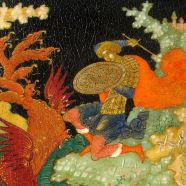
St. George Slaying the Dragon by the Palekh Master Vakurov, 1925 (Detail).
Share This
Print This
Email This
Nostalgia, Modernity, and the Russian Lacquer Boxes of Palekh
Rapid change is a given in the modern industrial world. It is often disorienting, producing, among other things, the quintessentially modern feeling of nostalgia, which is derived from the Greek word for pain from an old wound. Those who are attached to the past and lament its passing feel the pain of this wound, and they treat it in various ways: by arranging visits to a museum, antique shopping, watching the History Channel, connecting to their past through Ancestry.com, reading historical romances, or in the case of Russia, admiring a Palekh lacquer box.
The central Russian village of Palekh, located about 220 miles northeast of Moscow, was a center for the production of icons by Russian peasant masters. Since at least the seventeenth century, the village produced exquisitely detailed holy images in the Orthodox style. At first, the market for Palekh icons was driven by the wealthier segments of the peasantry and merchant class of Russia as well as Palekh’s aristocratic serf-owners. The village was known in particular for the fine detail in its gesso icons, using squirrel hair brushes and natural, egg-based pigments. Peasant masters remained faithful to the task of exactly copying the style and images of the Orthodox icon canon: the God-mother (Virgin Mary in the Catholic tradition), Christ the Savior, St. George Slaying the Dragon, the entry of Jesus into Jerusalem, and many others.
The Palekh tradition came to the attention of the broader group of educated Russian elites in the mid-nineteenth century. Urged to become more European since the time of Peter the Great at the beginning of the 1700s, many Russian elites had eschewed Russian traditions and looked instead to the Enlightenment in the West, refashioning themselves into what they considered to be modern, rational Europeans. The mid-1800s saw a reaction against modern European ways. Inspired by the ideas of German romanticism, some educated Russians experienced for the first time a feeling of alienation from their own culture and people, which fueled an intense desire to reconnect with lost traditions. Flipping the script on Peter the Great’s command to Europeanize themselves, they sought to recover their own sense of lost identity through Russian peasant folkways and religion. In their mind, the Palekh masters were salt-of-the-earth Russians, rooted in soils and landscapes of the central Russian village. They seemed to be living links to sacred national and religious pasts that would allow Russia, in the view of conservative elites, to ride out the storm of modernization and maintain Russia’s unique culture and civilization.
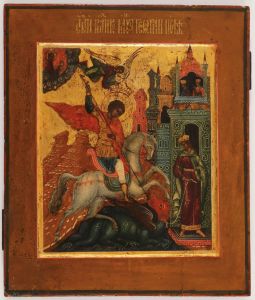
An example of a favorite motif of the Palekh icon painters from the late nineteenth century: St. George Slaying the Dragon. St. George is also the coat of arms of Moscow.
While elites gained a new appreciation of folk traditions such as Palekh, they also discovered a new danger to their newfound identity. That danger came in the form of Western market forces and Catholic influences that were supposedly endangering the sacred Russian traditions possessed by the Palekh peasant icon masters. The market for Palekh icons, according to conservative elites, was a kind of Trojan Horse that would allow Catholic and secular influences to shape and pervert Russia’s traditions and soul. In newspaper editorials and in academic circles that began to study Byzantine and Russian religious art and peasant traditions, conservative elites by the late 1800s urged the state to protect the Palekh masters from the corrupting forces of the market, Western easel art, modernization, secularization, and Catholic traditions.
The result of persistent lobbying to none other than the Emperor Tsar Nicholas II himself was the creation in 1902 of a special committee to control and protect Palekh’s religious art. A blue-ribbon panel of experts—Russian Orthodox art professors such as the Byzantinist Nikodim Kondakov—launched the committee, which immediately began to publish articles about the various non-Russian and non-Orthodox forces that the market for icons was introducing into the Russian countryside. The committee prepared manuals depicting the authentic Orthodox icon templates the peasant masters should follow. They set up a school to properly train the Palekh masters, using academic research and expertise bolstered by the authority of Tsarist power and advanced academic degrees. In the view of the committee, nothing less than the sacred foundations of Russia—its very soul that made it distinctive from the European West—was at stake.
Though the committee members were staunch monarchists and conservatives, they shared with Russian revolutionaries on the left a deep suspicion and hatred of the “market” and of everything associated with trade and the supposed bourgeois mentality. They rarely stopped to think about the impact of their attempts at control on the livelihood of the Palekh masters themselves whom they imagined they were protecting. Reflecting the antidemocratic spirit of the Tsarist system, it did not occur to the icon experts to ask the Palekh masters whether they agreed with the form and substance of the committee’s patronage.
The Bolshevik Revolution in October 1917 was among many other things a decisive rejection of the Russian past and in particular peasant life associated with Russian Orthodoxy and the traditional patriarchal family. But liberating it was not, at least for the Palekh icon painters. One authoritarian system seemed to replace another. The Palekh masters, predictably, were attacked viciously as the embodiment of everything the revolution hated: reliance on market forces, the spread of religious ideas and imagery, and the backwardness of the patriarchal structures of the Russian countryside.
However, unexpected things happened on the way to the glorious communist future. If the Bolshevik authorities expressed disdain for religion and the Russian peasant past, they also realized that there was a vibrant market for Russian arts and crafts in the capitalist West, especially given the perception that such traditions were fast fading and in their twilight. Even more important, the Bolsheviks were desperate for money with which to buy the machine tools and technology they needed for their modernization plans, and Russian arts and crafts were one of the few products they had to sell to well-heeled Westerners. So the communist authorities permitted the opening of shops to sell Russian peasant arts and crafts to foreigners, primarily in Moscow.
Led by the Palekh icon-painter Ivan Golikov, the Palekh masters discovered the growing demand in the early 1920s for Russian peasant folkways. It would have been too much, of course, for the Palekh masters to continue producing religious icons in a vehemently atheist state, so Golikov (who was trained in Imperial Russia by the Tsarist committee to protect religious icons) happened upon the idea of using the traditional icon painting techniques and egg-based tempera paints in a new medium: the papier-mache lacquer box that he had seen on display in the arts and crafts shops of Moscow. He also swapped out the old holy images for new miniature images taken from Russian folk tales and representing a romantic Russian idyll. He presented the new/old art form as a revolutionary transformation of the obscurantist peasant countryside. He also did something else that was truly revolutionary for Palekh: he signed his name to his work. The religious icon was never signed and was thought to represent not the artist’s muse but the will of God as expressed through the artist. By the mid-1920s word got back to the village about Golikov’s successes in selling these boxes to foreigners, and other masters followed his example, transforming themselves from icon painters into miniature lacquer-box specialists with their own artistic identities, but expressed and contained within the national traditions and techniques of the Russian countryside. They were celebrated by Soviet propagandists. Occasionally, the Palekh masters also inserted tractors and political leaders into the microcosm of the Palekh lacquer box—incongruously, perhaps, in the old Russian Orthodox religious style.
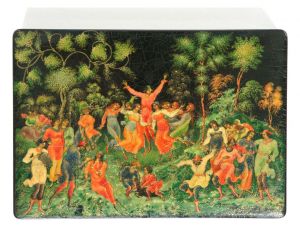
This box was made by the Palekh master Ivan Golikov in 1930 depicting a Russian rural idyll in the distinctive Palekh style.
Against all odds the Palekh masters thrived as lacquer-box artists, but they also faced periodic waves of attacks—in the 1930s and again after WWII—for their connections to both religious traditions and as symbols of the patriarchal traditions that the revolution had attempted to overcome. For many militant Marxist revolutionaries, they embodied what Marx had termed the “idiocy,” superstition, and ignorance of rural life. Their salvation, ironically, was their link to the very thing the communists hated: the market and capitalist demand. Ultimately, the money that Palekh masters generated for the state through the international market for arts and crafts mattered more than the protests of militant, antimarket and antipeasant commissars.
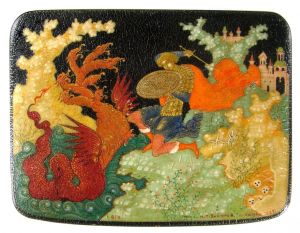
The Palekh Master Vakurov in 1925 reproduced the favorite icon of St. George Slaying the Dragon in the medium of the lacquer box.
By the 1960s and 1970s, and briefly during WWII, some Palekh masters even returned to painting religious icons, though very discreetly. They gained a reputation as restorers of religious icons for many museums of Russian culture created by the Soviet state. Soviets of the post–World War II period celebrated the Palekh masters as organic links to an ancient past that had survived the various ruptures and cataclysms of Russian history. Soviet propaganda sometimes referred to the masters as living examples of a famous short story in 1881 by the Russian writer Nikolai Leskov called “The Lefthander” (Levsha in Russian). It was a tale of a Russian peasant craftsman in an armory of Tula who outdid his English colleagues by fashioning a horseshoe for a flea. The story expressed the idea that Russian craftsmen could outdo their more technologically advanced Western European competitors. Curiously, like the Palekh lacquer box, the horseshoe for a flea had little practical use, though it was certainly a sight to behold (with a microscope).
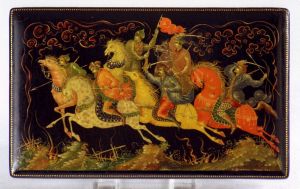
In this 1934 box, the Palekh master Blokhin represented Bolshevik Red Army fighters in the traditional Russian Orthodox icon painting style.
Today, the Palekh masters have two traditional art forms: the “ancient” lacquer-box, filled with folk motifs, and the Orthodox religious icons, which re-emerged decisively with the collapse of the Soviet Union. Both art forms are a result of what the famous revolutionary Leon Trotsky once called the phenomenon of “combined development.” Trotsky noted that the challenge of development in less industrialized countries such as Russia was that they would have to figure out how to use revolutionary power to combine centuries of development into a few short decades. In this way, they would be able to catch up to the more advanced industrial capitalist countries and defend their revolutionary power. However, Trotsky cautioned that the more radical the desire to make a break with the past, and the more rapid the attempt to move into the industrial future, the more aspects of the supposedly backward past would unintentionally be reinforced in the new society and culture. As the Palekh masters illustrate, the past in Russia constantly exacted revenge on those who tried to part with it. One way or another the bygone Russian ways asserted themselves—with some generous financial help from Westerners, from the global market for arts and crafts, and fueled by a desire to salve the deep wounds of nostalgia that the modern world is so good at producing.






